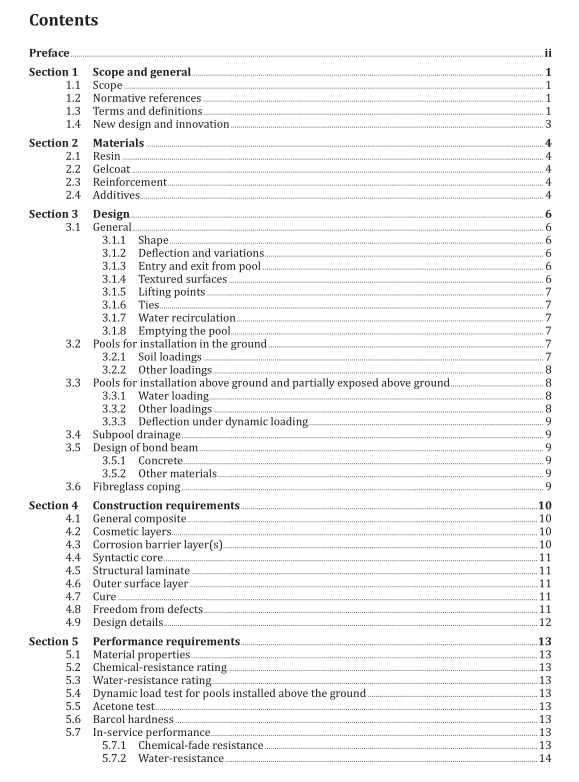AS 1838 pdf download – Swimming pools — Premoulded fibre- reinforced plastics — Design and fabrication

AS 1838 pdf download – Swimming pools — Premoulded fibre- reinforced plastics — Design and fabrication
NOTE The slip potential of pool surfaces is affected by contaminated water (chemicals),contamination by bodyfats, contaminated feet (contaminated water and body fats) and the gradient.
3.1.5 Lifting points
Lifting points shall be provided to enable the pool to be lifted and manoeuvred as required.Thelifting points on any one side shall have a combined capacity of at a minimum 1.5 times the weight ofthe pool shell.
3.1.6 Ties
Where a bond beam is a structural element of the pool,provision shall be made for structurallyconnecting the bond beam to the pool shell.
3.1.7 Water recirculation
Skimmer boxes and other outlet types shall conform to AS 1926.3.
3.1.8 Emptying the pool
Specific details relating to emptying the pool shall be provided in the operating and maintenanceinstructions (refer to AS 1839), for use in situations where it may become necessary to drain the water.NOTE Pre-moulded fibre-reinforced (FRP) swimming pools, that are designed for in-ground installation, arenot designed to be left empty for extended periods of time.Failure to abide by the manufacturer’s instructionsand guidelines when draining a pool may result in deflection and damage to the pool shell and the installation.
3.2Pools for installation in the ground
3.2.1Soil loadings
The pool shall be designed so that it withstands at a minimum the following external loadings that maybe applied by the soil profile and backfill encountered at a typical location in which the pool shell is tobe installed.
The design soil types shall be clearly stated on the design drawings.The design horizontal pressure shall be not less than—
(a
4.8 kPa/m depth for sand only; and
(b)
6.6 kPa/m depth for clay and soil.
The pool, when full of water, shall be designed to resist the additional pressure from a surcharge of2 kPa on the ground surrounding the pool.
NOTE 1 For guidance on pool design see Appendix B.
NOTE 2The design values do not take account of loads due to hydrostatic, hydrodynamic and reactive claypressures.For guidance on such loadings, see Appendix B.Refer to AS 1839 for additional requirements for theinstallation of the pool in these conditions.
NOTE 3 The design values do not take into account loads due to heavy machinery and equipment. Where suchloading may occur, it may be necessary to brace the walls.
3.2.2 Other loadings
The design of the pool shall take into account the following:
(a) Temporary loads during transportation.
(b) Lifting point loads.
(c) Loads due to earthquake, conforming to AS 1170.4, where applicable.
The design of the pool and the installation methods used shall take into account special loadings peculiar to the specific locality of the installation, including loads from —
(i) hydrostatic pressure;
(ii) hydrodynamic pressure; and
(iii) reactive clay pressure.
NOTE 1 For guidance on such loadings, see Appendix B. Refer to AS 1839 for additional requirements for the installation of the pool in these conditions.
NOTE 2 Hydrodynamic pressure may occur where a hard strata such as rock or shale is present near the pool.
The most typical effect is disturbance of backfill or pool bedding.
3.3 Pools for installation above ground and partially exposed above ground
3.3.1 Water loading
The pool, when full of water, shall be capable of withstanding the internal loading due to static and dynamic water pressure in accordance with the requirements of this document, without the use of temporary external bracing. The minimum pressure shall be calculated from the hydrostatic head due to water of density 1 000 kg/m 3 .
The design of the pool shall also take into account the effects of dynamic and unsymmetrical loading.
3.3.2 Other loadings
The design of the pool shall take account of the following:
(a) Temporary loads during transportation.
(b) Lifting point loads.
(c) Loads due to earthquake, conforming to AS 1170.4, where applicable.
(d) Dynamic loading test, see Appendix C.
The design of the pool and the installation methods used shall take into account special loadings peculiar to the specific locality of the installation, including loads from —
(i) hydrostatic pressure;
(ii) hydrodynamic pressure;
(iii) reactive clay pressure.
NOTE 1 For guidance on such loadings, see Appendix B. Refer to AS 1839 for additional requirements for the installation of the pool in these conditions.









